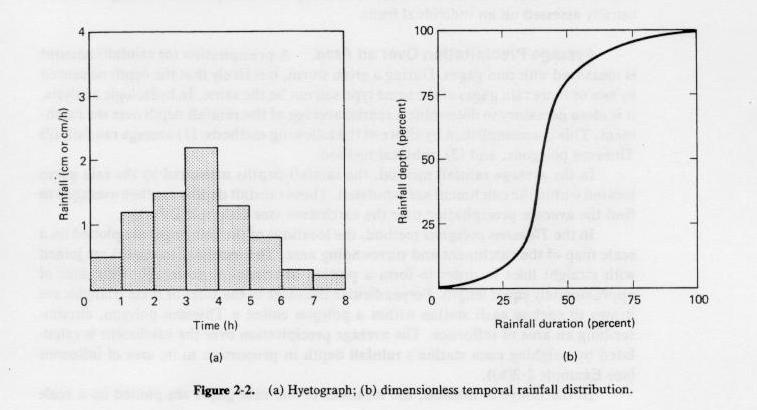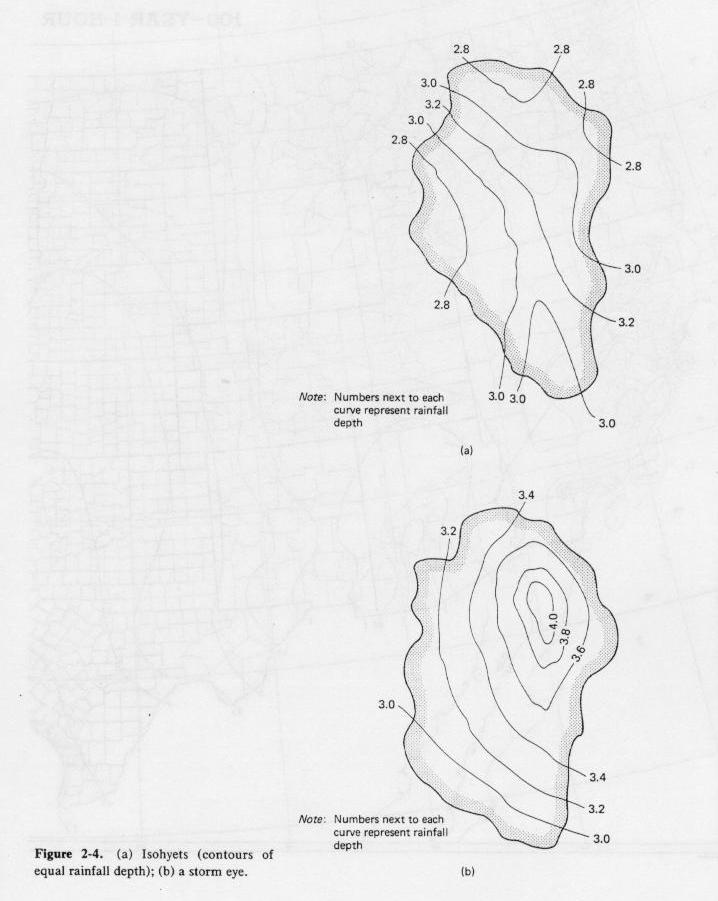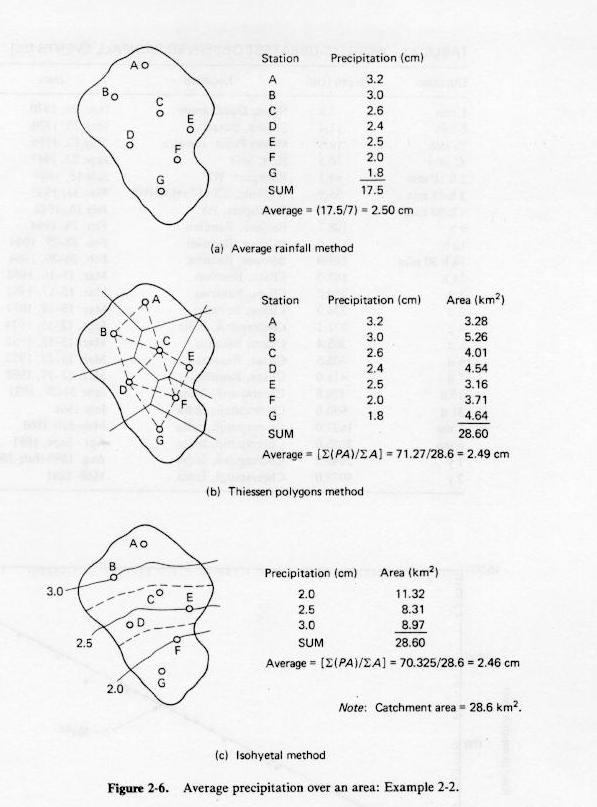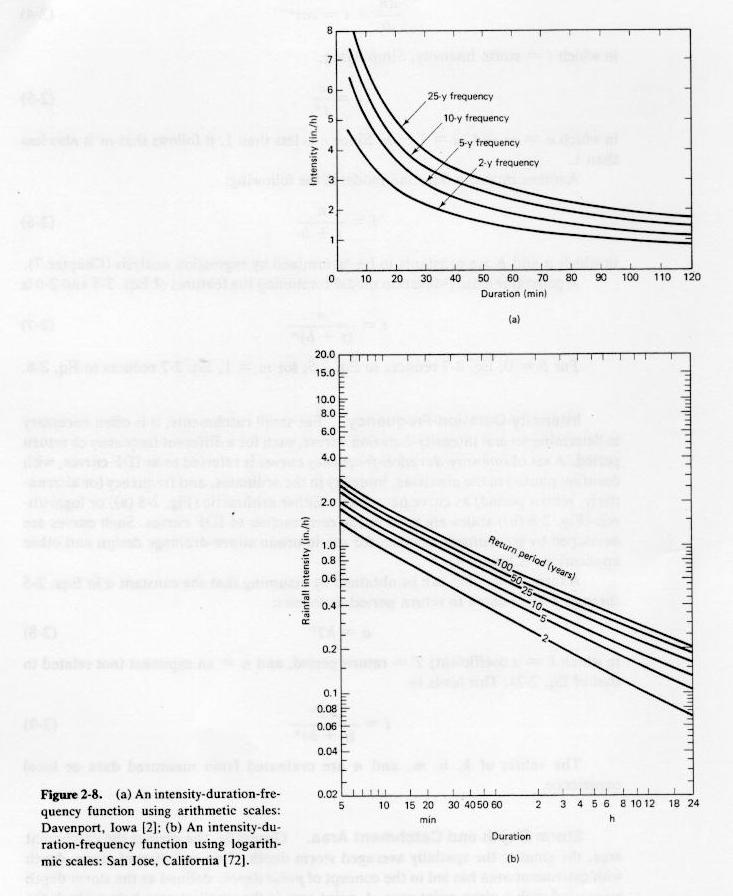|
|
CIVE 445 - ENGINEERING HYDROLOGY
CHAPTER 2A: BASIC HYDROLOGIC PRINCIPLES, PRECIPITATION
|
- Engineering hydrology takes a quantitative view of the hydrologic cycle.
- Rainfall is the liquid form of precipitation.
- The catchment has an abstractive capability that acts to reduce total rainfall into effective rainfall.
- The difference between these two is the hydrologic abstractions.
- Hydrologic abstractions include
- interception,
- infiltration,
- surface storage,
- evaporation, and
- evapotranspiration.
- Effective rainfall and runoff are equivalent.
- Hydrologic mass balance equations use units of mm, cm, on inches, uniformly distributed over the entire catchment.
- The Earth's atmosphere contains water vapor.
- The amount of vapor is expressed as a depth of precipitable water.
- The amount of water vapor contained in the air is a function of the temperature.
- Lowering of the temperature reduces the amount of water vapor that the air can contain.
The rest is precipitated.
- Cooling of air masses can be due to:
- Horizontal convergence lifting: moist air masses move to low-pressure area, collide,
vapor raises, and cooling results.
- Frontal lifting: warm moist air moves into colder air, which acts as a wedge;
warm air rises, and cooling results.
- Orographic lifting: moist air flows toward an orographic barrier and is forced to rise,
resulting in its cooling.
- Longwave-radiation lifting: in heavily vegetated regions, with low albedo,
excess longwave radiation warms moist air and results in its lifting.
- Condensed water vapor must attain precipitation size in order to precipitate.
- Air particles such as aerosols trigger coalescence of condensed water vapor into rain drops.
- Factors affecting precipitation (Link 4203).
Quantitative description of rainfall
- Rain consists of liquid-water drops, mostly larger than 0.5 mm in diameter.
- Rainfall intensities can be light (less than 3 mm/hr) to heavy (more than 10 mm/hr).
- Snow is ice crystals.
- Hail is solid icestones, from 5 to 125 mm in diameter.
- Rainfall durations of 1, 2, 3, 6, 12, and 24 hr are common.
- Rainfall depths can vary widely, depending on climate and season.
- Larger depths occur more infrequently.
- For example: a 60 mm rainfall lasting 6 hr may occur once every 10 yr (Intensity-Duration-Frequency).
- Return period is the reciprocal of the frequency: once in 50 yr (1/50) means a 50 yr return period.
- For long return periods, data is lacking to support statistical analysis (more than 100 years).
- Deterministic concept of PMP (Probable Maximum Precipitation) takes over in the U.S.
- PMP leads to PMF (Probable Maximum Flood).
- SPF (Standard Project Flood) is a fraction of the PMF (Corps of Engineers practice).
- Q&A on the return period to be used for design. (Link 4221).
Temporal rainfall distribution
- Variation of rainfall depth within the event duration is depicted by the temporal rainfall distribution.
- Discrete form is the hyetograph.
- Continuous form is the temporal rainfall distribution (Fig. 2-2)

Fig. 2-2
|
|
Spatial rainfall distribution
- The same amount of rainfall does not fall uniformly over the entire catchment.
- Isohyets depict the spatial variation of rainfall (Fig. 2-4)
- In regional rainfall maps, isohyets are referred to as isopluvials.
- San Diego County 24-hr isopluvials.

Fig. 2-4
|
|
Average precipitation over an area
- It is often necessary to determine a spatial average of precipitation.
- This is performed in three ways:
- Average method: raingage depths are averaged without regard to intensity or areal distribution.
- Thiessen polygons: raingage locations are joined with straight lines, and perpendicular bisectors determine the area of influence
of each raingage.
- Isohyetal method: raingage depths are used to draw contours of equal rainfall (isohyets); mid-distance between two adjacent isohyets
determine area of influence of each isohyet.

Fig. 2-6
|
|
Storm analysis
- Storm depth h and duration t are directly related.
- Exponent n varies between 0.2 and 0.5.
- Depth-duration data for the world's greatest observed rainfall events.

Fig. 2-7
|
|
- Differentiating rainfall depth with respect to duration:
- Simplifying:
- in which a = cn; and m = 1 - n.
- A more general intensity-duration model is:
- An intensity-duration-frequency model is:
- in which K = a coefficient; and n = an exponent.

Fig. 2-8
|
|
Storm depth and catchment area
- Generally, the greater the catchment, the smaller the spatially averaged storm depth.
- Point depth is the storm depth associated with a point area.
- Point area is the smallest area below which the variation of storm depth with catchment area is assumed negligible.
- Reduction in point depth is warranted for large catchments.
- NWS depth-area reduction charts are available.

Fig. 2-9
|
|
Depth-duration-frequency
Depth-area-duration
- This is an alternate way of portraying the reduction of storm depth with area, with duration as a third variable.

Fig. 2-10
|
|
Sources of precipitation data
Filling in missing records
- Incomplete records of rainfall are sometimes due to operation error or equipment malfunction.
- The mean annual rainfall N for stations X, A, B, and C is evaluated.
- If the mean annual rainfall at A, B, and C is within 10% of that of X, a simple average is sufficient.
- If not, then the normal ratio method is used to fill in missing records at station X:
|
PX = (1/3) [(NX/NA)PA + (NX/NB)PB
+ (NX/NC)PC ]
|
- in which P = precipitation, N = mean annual rainfall, for stations X, A, B, and C.
- In the NWS method, data for four neighboring stations (one in each quadrant) is weighted in proportion to the reciprocal of the square of
its distance to station X.

Fig. 2-11
|
|
- The procedure is described by the following formula:

Eq. 2-11
|
|
Double-mass analysis
- Consistency of a rainfall record is tested with double-mass analysis.
- This method compares the cumulative annual or seasonal values of station Y with those of a reference station X.
- The reference station X is usually the mean of several neighboring stations.
- The cumulative pairs are plotted in an x-y coordinate system.
- If the plot is linear, the record for Y is consistent.
- If the plot shows a break in slope, the record for station Y is inconsistent.
- Correction is performed by adjusting the records prior to the break to reflect the new state (after the break).
- The rainfall records prior to the break are multiplied by the ratio of slopes after and before the break.

Fig. 2-12
|
|
Go to Chapter 2B.
|









